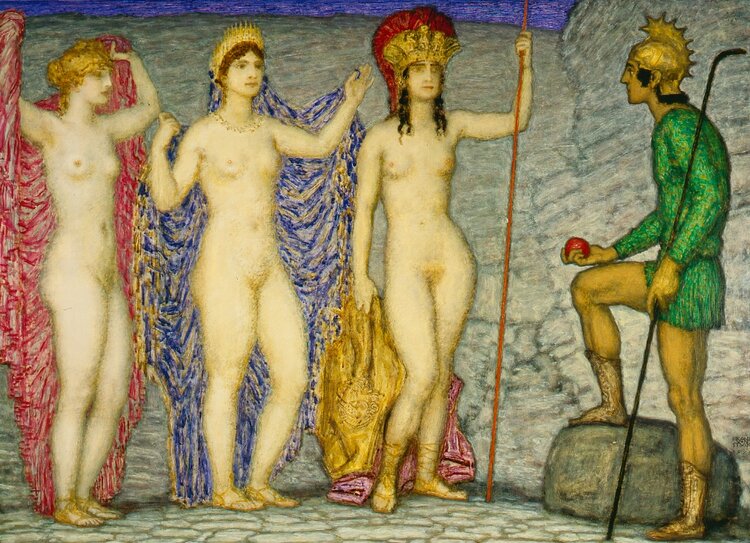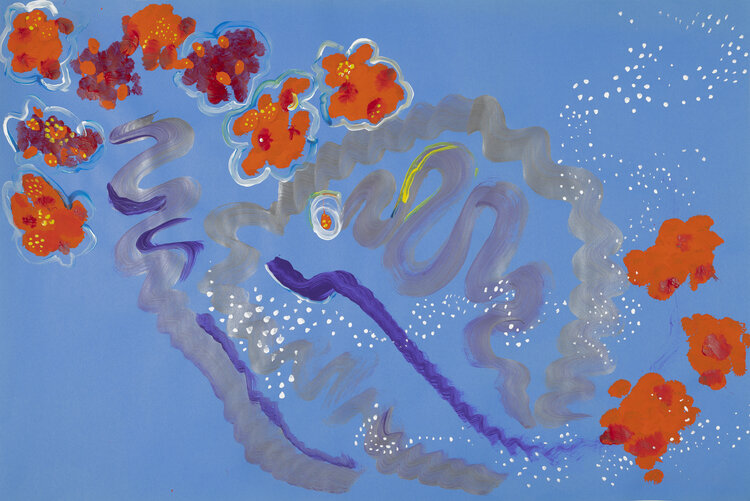As part of the Frye’s Gallery Guide Internship in partnership with Seattle University, Gallery Guide Interns had the opportunity to develop and facilitate a virtual tour of artworks from the Frye’s collection and exhibitions.
This tour will be exploring the theme of Art and Inspiration, focusing on how artists influence or are influenced by other works of art. With inspiration from poetry, stories, and music, these artworks show how ideas and feelings can be translated across different media. I hope that this discussion can encourage you to make connections of your own, either on your next visit to the museum or elsewhere in your daily life.

Franz von Stuck (German, 1863–1928). Urteil des Paris (The Judgment of Paris), 1923. Oil on panel. 28 3/8 x 39 1/2 x 1/2 in. Founding Collection, Gift of Charles and Emma Frye, 1952.168
Take a moment to look closely at this work.
-
What visual elements does Stuck use to tell the story?
-
Who is the main character of the story? Which visual elements does the artist use that makes you say that?
-
Take a moment to read about the story behind The Judgement of Paris. Knowing the story, is there anything you would change about the way Stuck has depicted it? What might this painting look like after Paris has awarded the apple?
-
Why might the artist have chosen to paint this scene in particular?
Franz von Stuck (February 23, 1863–August 30, 1928) was a prominent German painter, sculptor, engraver, and architect who rose to fame around the turn of the twentieth century. Trained at the Academy of Fine Arts in Munich, he began to gain recognition for his engravings in the early 1880s while he was still a student.
Much of Stuck's work features an interest in Christian imagery and classical mythology with an emphasis on the erotic. This can be seen not only in The Judgement of Paris, but also in Sin, a version of which was also on display in the exhibition Unsettling Femininity: Selections from the Frye Art Museum Collection and is considered to be one of his most famous and influential works.
Stuck is best known for his association with and co-founding of the Munich Secessionist movement in 1893. His influence on the movement was extensive, and he created several of the Secession posters, including the famous image of Athena which was used for the first Secession exhibition in 1893 and later became the Secessionists' symbol. He also later became a professor at the Munich Academy where he would go on to influence such pupils as Paul Klee and Vasily Kandinsky.
While our first artwork was inspired by stories of the Trojan War, the next is a piece of creative writing that uses vivid imagery to inspire the reader to imagine the things described.

Installation view of Anastacia-Reneé: (Don’t be Absurd) Alice in Parts, Frye Art Museum, Seattle, January 30–April 25, 2021. Photo: Jueqian Fang
![Anastacia-Reneé. Excerpt from Untitled [#14, Alice has decided she will create a graphic novel].](/sites/default/files/images/full-width/Untitled%2Bexcerpt.png)
Anastacia-Reneé. Excerpt from Untitled [#14, Alice has decided she will create a graphic novel]. Vinyl. Courtesy of the artist.
Take a moment to closely read the text above.
-
What image in this poem stands out to you the most? Which can you visualize easiest? Why?
-
What can this poem tell us about the main character, Alice?
-
Would it change the meaning of this piece if you could see the images from Alice’s graphic novel? How? Why?
-
Why might the artist have chosen to write this out instead of depicting the images they write about?
Anastacia-Reneé (American, b. 1972) is an award-winning, widely published writer, playwright, and interdisciplinary artist who lives and works in Seattle. Her work centers on issues of marginalization and erasure in American society. Rooted in the Black feminist tradition, Anastacia-Reneé takes an intersectional approach to looking at issues of racism, sexism, homophobia, agism, and class.
In the 2021 exhibition Anastacia-Reneé: (Don’t be Absurd) Alice in Parts, the artist presented a "rageful meditation" on gentrification through the eyes of her character Alice Metropolis (b. 1980, She/They/Unicorn). The exhibition guided visitors through Alice's life, literally leading them through her house and her thoughts. (Don’t be Absurd) Alice in Parts focused on Alice’s struggles against various forms of gentrification, from her displacement from her home and neighborhood to the colonization of her body by cancer cells, and of her mind by the anxiety and terror of navigating white supremacy every day.
As shown in the installation view above, Untitled [#14, Alice has decided she will create a graphic novel] occupied much of the wall of the second room of the exhibition. It was placed next to a bed over which a speaker played a recording of Alice's restless thoughts as she tries, unsuccessfully, to sleep. How might this poem offer us insight into Alice's character? Into their poetry? Into the world they live in?
Related Resource: Take a virtual tour of Anastacia-Reneé: (Don’t be Absurd) Alice in Parts.
This next artwork was created by participants in one of the Frye Art Museum's Creative Aging programs.

Kirsten Kinnan, Margot Hughes McDonald, and Emma Levitt Royer. Untitled, 2020. Acrylic on paper, applied collaboratively in response to the rhythms of music. 36 x 24 in.
Take a moment to look closely at this artwork.
-
What is the first thing you notice about this piece? What visual elements stand out to you the most?
-
Do you see movement represented in this piece? If so, how might you describe the movement?
-
How does this artwork make you feel? What emotions do you think the artists might have felt while painting it?
-
This artwork was created in response to music. What sort of music might the participants have been listening to while they were painting? (Feel free to sing out loud, play some music for the people around you, or describe a genre of music.)
For the past decade, the Frye has offered programs for older adults to engage in creative lifelong learning and build community around art. Many Creative Aging programs have supported adults living with dementia and their care partners through artwork discussion and art-making.
During a here:now class in winter 2020, participants explored the theme of movement by looking at photographs and videos of Seattle-based choreographer and dancer Donald Byrd in Donald Byrd: The America That Is To Be. After the gallery discussion, participants responded by creating this collaborative painting while listening to music. This piece is included in the exhibition at the Frye Art on the Mind: Ten Years of Creative Aging.
I invite you to take a moment to think back on the works we explored together. Have you been inspired by any of them? If so, it may be useful to start with a work in one medium and try to translate it into another one. How might the painting from Art on the Mind sound, taste, or feel? How might you write a poem inspired by Stuck's The Judgement of Paris? What might Anastacia-Renee's Untitled [#14] look like as a painting, a sculpture, or a work of prose?
Please feel free to take some time to write, draw, compose, sculpt, or otherwise create your response to these works in the medium of your choice. We look forward to seeing what you come up with!
Adina Van Etten
2021-22 Seattle University Gallery Guide Intern